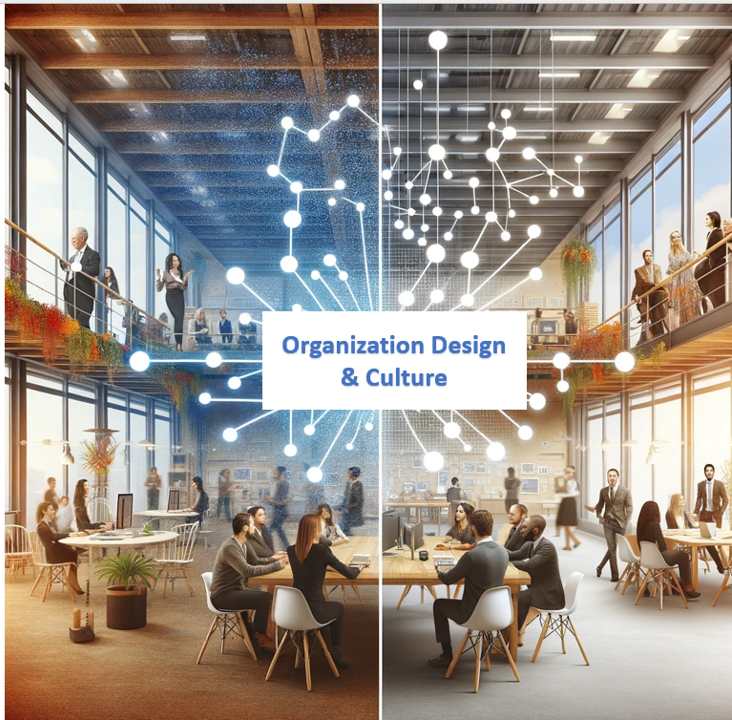Imagine a scenario we've seen unfold time and time again: A company that prides itself on being a tech innovation trendsetter embarks on a high-spirited journey to revamp its corporate culture. Leadership is all in, pouring resources into comprehensive workshops, inspirational team-building retreats, and even a vibrant rebranding of company values that now grace every corner of the office and the digital workspace alike. Management feels good. Employees have their healthy, but well-camouflaged doubts.
Fast forward six months, and the initial buzz has unmistakably worn off. The much-anticipated cultural shift seems more like a distant mirage than a tangible reality. Management has become a lot quieter around the company’s culture and employees can add another experience to their long change fatigue list. The culprit? An untouched organizational environment that quietly but effectively undermines each new initiative and intrinsically dictates “how we do things around here.”
The Culture Absorption Effect of Structure
This tale is far from unique in the corporate world. It highlights a critical oversight many organizations suffer from, i.e., the failure to recognize that the bedrock of any lasting transformation is not the initiatives themselves, but the organization design that has the power to evoke new behavior. Refusing to look at the organization's design, operating models, and team processes resembles saying that we want to change everything, we just don’t want to change anything. This article aims to bridge the gap between ambition and reality in cultural transformation efforts, highlighting the critical yet often overlooked role of organizational design. By focusing on structure as a catalyst for cultural change, leaders can create a conducive environment for the values and behaviors they wish to see flourish within their organizations.
Structure Drives Behavior
Before we explore the specifics of how organizational design elements like process, operating models, incentives, and organizational structure influence behavior, it's crucial to understand the foundational principle underlying this dynamic: Structure drives behavior.
At its core, this principle suggests that the way an organization is designed—its systems, its processes, and its hierarchy tolerance—sets the stage for how its people act, interact, and make decisions. This is because structures create the boundaries within which people operate, guiding their actions and decisions, often subconsciously. When these structures are misaligned with the company's goals, they can significantly hinder the achievement of those goals, regardless of the individual qualities or intentions of the people within the system.
Take our fictitious case organization, a company that prides itself on pushing the boundaries of technology and striving for a culture brimming with innovation and creativity. Their vision is clear: to be a place where groundbreaking ideas are born, where risks are taken, and where the status quo is continuously challenged. However, ambition alone does not instigate change. The structure within which our fictitious company operates plays a pivotal role in whether this vision can be realized.
Why? Because innovation thrives in environments where ideas can be freely exchanged, where decisions can be made swiftly, and where failure is seen as a step toward success, not a setback. A hierarchical structure, by its very nature, tends to slow down decision-making, discourage risk-taking (due to the fear of repercussions from higher up), and siloed information and ideas within departments, making cross-functional collaboration challenging.
In the case of our fictitious innovation player, their structure inadvertently creates barriers to the very behavior they wish to cultivate. Employees, regardless of their creativity or drive, find themselves navigating a maze of approvals for even minor innovations, leading to frustration and a gradual decline in their willingness to put forward new ideas. The signal sent by the organizational structure is clear: proceed with caution, maintain the status quo, and avoid risks that could lead to failure.
This misalignment between structure and cultural aspirations highlights a critical oversight. Without addressing and realigning their organization design to support their innovation goals, our case company's initiatives aimed at fostering a culture of innovation are likely to be stifled, no matter how much they invest in workshops, training, or external consultants preaching the virtues of innovation.
Behavior Levers on a Team or Enterprise Level
Whether you are a company or a team leader who would like to see different behavior and nurture a different culture: There are many processual, even minimally invasive, changes you can make to nourish the desired mindset and collaboration.
Organization Design: The choice between a hierarchical versus a more open, networked organizational structure can profoundly influence communication patterns, decision-making processes, and the overall culture. Hierarchies may create clear lines of authority but can also lead to bottlenecks and a culture of deference. An open or flat structure can encourage a more collaborative and inclusive culture but may require stronger coordination mechanisms to avoid chaos.
Operating Models: An operating model that's misaligned with the company's vision can create silos, inefficiencies, and confusion. For instance, a company aiming for a culture of collaboration and cross-functional innovation but operating in noticeable silos is setting itself up for failure. Aligning the operating model with the desired culture means breaking down barriers and creating a structure that facilitates collaboration and flexibility.
Process: Consider teams where the process flow leads to a lack of coordination and added layers of approvals for minor decisions. This disrupted team flow not only slows down operations but also stifles creativity and autonomy, leading to a culture of dependency and risk aversion. In contrast, dynamic processes that empower decision-making at lower levels can foster a culture of trust, innovation, and agility.
Incentives: Incentive structures are perhaps the most direct way organizations signal what behaviors are valued. If incentives are solely based on individual performance metrics, they may inadvertently promote a cutthroat and siloed environment, undermining efforts to cultivate a collaborative culture. Conversely, incentives that reward team achievements and recognize contributions to collective goals can enhance a sense of unity and shared purpose.
Without addressing these structural elements, any cultural initiative risks being absorbed and nullified by the existing organization design and bottlenecked processes. Structures that are deeply misaligned with the desired culture act as a sponge, soaking up the energy and resources thrown into culture change without any significant shift in behavior or mindset. This absorption effect means that despite the best intentions, the legacy structure can dilute or even completely negate the impact of cultural initiatives.
Building the Organizational Foundation for Cultural Success
Recognizing the paramount importance of structural engagement with cultural aspirations leads us to a crucial credo for leaders: To cultivate a desired culture, one must first get the house in order. This involves:
- Conducting a thorough and honest assessment of the current organization design e.g. team processes - and their compatibility with the envisioned culture.
- Being prepared to undertake the challenging but necessary process of structural redesign, including processes, operating models, and incentive systems.
- Viewing organizational design not as a static framework but as a dynamic, evolving element that must be continuously aligned with the organization's strategic goals and cultural aspirations.
The journey toward cultural transformation is both complex and challenging. Yet, by recognizing and addressing the foundational role of organizational design, companies can significantly enhance their chances of success. Sustainable cultural change is built on the bedrock of a thoughtfully designed organization—one that supports and amplifies the desired behaviors and values. As leaders, the challenge is to ensure that your organizational design is not sabotaging your cultural ambitions but rather serving as a catalyst for genuine, lasting change – and a truly vibrant culture.










